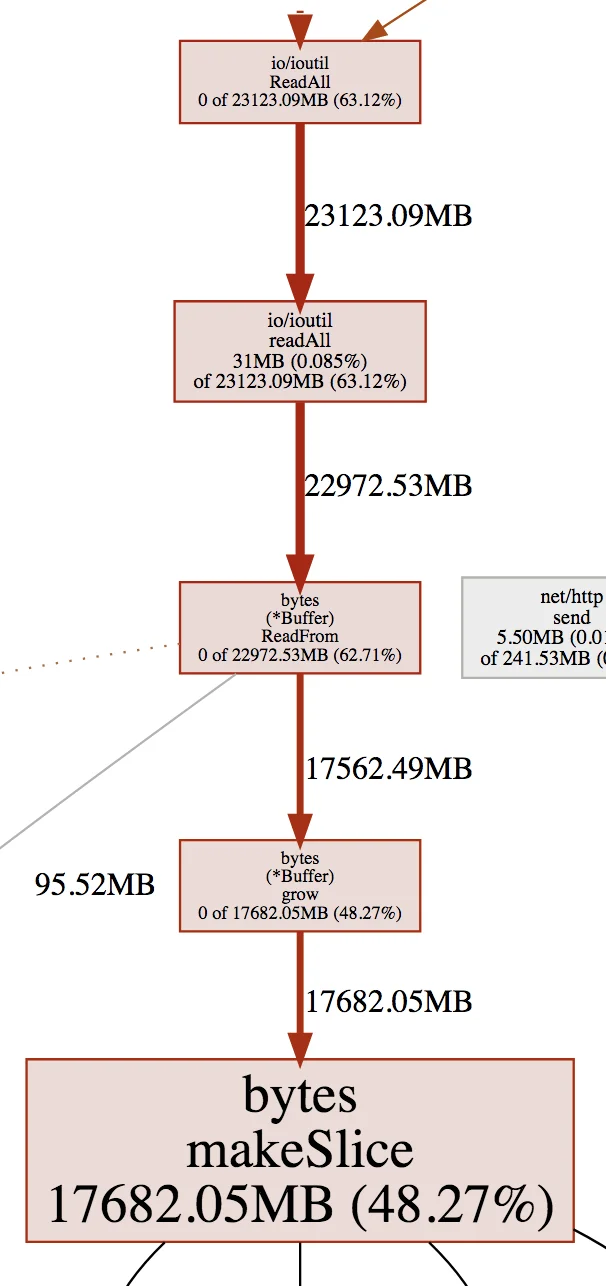1. 前言
imroc/reqio.Copyioutil.ReadAll2. 起因
imroc/req有如下调用关系
Resq.Bytes() -> Resq.ToBytes() -> ioutil.ReadAll(r io.Reader) -> Buff.ReadFrom(r io.Reader)
使用pprof收集内存累计分配情况可以发现大量的内存分配由Buffer.grow(n int) 触发

3. 原因分析
ReadFrom的源码如下
// MinRead is the minimum slice size passed to a Read call by
// Buffer.ReadFrom. As long as the Buffer has at least MinRead bytes beyond
// what is required to hold the contents of r, ReadFrom will not grow the
// underlying buffer.
const MinRead = 512
// ReadFrom reads data from r until EOF and appends it to the buffer, growing
// the buffer as needed. The return value n is the number of bytes read. Any
// error except io.EOF encountered during the read is also returned. If the
// buffer becomes too large, ReadFrom will panic with ErrTooLarge.
func (b *Buffer) ReadFrom(r io.Reader) (n int64, err error) {
b.lastRead = opInvalid
for {
i := b.grow(MinRead)
m, e := r.Read(b.buf[i:cap(b.buf)])
if m < 0 {
panic(errNegativeRead)
}
b.buf = b.buf[:i+m]
n += int64(m)
if e == io.EOF {
return n, nil // e is EOF, so return nil explicitly
}
if e != nil {
return n, e
}
}
}
MinReadBuffer.grow()// grow grows the buffer to guarantee space for n more bytes.
// It returns the index where bytes should be written.
// If the buffer can't grow it will panic with ErrTooLarge.
func (b *Buffer) grow(n int) int {
m := b.Len()
// If buffer is empty, reset to recover space.
if m == 0 && b.off != 0 {
b.Reset()
}
// Try to grow by means of a reslice.
if i, ok := b.tryGrowByReslice(n); ok {
return i
}
// Check if we can make use of bootstrap array.
if b.buf == nil && n <= len(b.bootstrap) {
b.buf = b.bootstrap[:n]
return 0
}
c := cap(b.buf)
if n <= c/2-m {
// We can slide things down instead of allocating a new
// slice. We only need m+n <= c to slide, but
// we instead let capacity get twice as large so we
// don't spend all our time copying.
copy(b.buf, b.buf[b.off:])
} else if c > maxInt-c-n {
panic(ErrTooLarge)
} else {
// Not enough space anywhere, we need to allocate.
buf := makeSlice(2*c + n) // **注意这里**
copy(buf, b.buf[b.off:])
b.buf = buf
}
// Restore b.off and len(b.buf).
b.off = 0
b.buf = b.buf[:m+n]
return m
}
makeSlice(n int)4.优化方案
makeSlice(n int)为了验证方案,这里做出对比试验
1)未优化代码
2)优化代码
执行10,000次的操作的结果对比
| 指标 | 未优化方案 | 优化方案 |
|---|---|---|
| mem.TotalAlloc(为堆对象总计分配的字节数) | 186,170,656 | 42,164,192 |
| mem.Mallocs(为创建堆对象总计的内存申请次数) | 732,161 | 681,532 |
| mem.Frees(为销毁堆对象总计的内存释放次数) | 717,737 | 661,557 |
由上面图表知,临时对象的申请和释放次数都有明显下降,优化方案是有效的(事实上随着执行次数的增加,指标的差距还会进一步拉大)。
其它类似场景的优化
在某些情况下,你可能会用到io.Copy
io.Copy(dst Writer, src Reader)
io.Copyio.CopyBufferio.Copyio.CopyBuffer(dst Writer, src Reader, buf []byte)
sync.Pool请我喝瓶饮料

